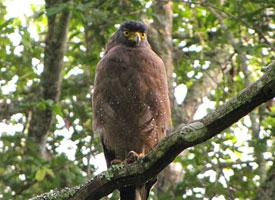
Váhy a míry
| Délka | od 49 do 57 cm |
|---|---|
| Hmotnost | od 570 do 1750 g |
| Délka rozpětí křídel | od 93 do 127 cm |
Popis zvířete
The Eurasian goshawk (Accipiter gentilis) is a large bird of prey, renowned for its remarkable agility and power, which it exhibits as it navigates through dense woodlands in pursuit of its prey. This raptor is a member of the Accipitridae family, which includes other hawks, eagles, and kites. The species is widespread across the temperate parts of the Northern Hemisphere, ranging from Europe and North Africa through Asia to North America.Adult Eurasian goshawks present a striking appearance. They typically measure about 46 to 61 cm (18 to 24 inches) in length, with a wingspan ranging from 103 to 127 cm (41 to 50 inches). Males are generally smaller than females, a common trait among birds of prey. Their plumage is characterized by a blend of slate gray and white colors. The upper parts of their bodies are a sleek, dark gray, while the underparts are lighter, with fine, horizontal barring. A distinctive feature of the Eurasian goshawk is its red eyes, set in a face framed by a sharp, hooked beak and crowned with a notable supercilium or eyebrow, giving it a fierce expression. Juvenile birds differ in appearance, displaying a brownish coloration with streaked underparts, and their eyes are a pale yellow, gradually changing to the deep red of adulthood.
Eurasian goshawks are solitary and territorial birds, especially during the breeding season. They inhabit large, mature forests, preferring areas that offer a mix of coniferous and deciduous trees. The dense canopy provides cover, allowing them to ambush prey, which includes a wide variety of animals. Their diet is opportunistic and diverse, ranging from birds, including other raptors and game birds, to small mammals like squirrels and rabbits, and occasionally reptiles and insects. They are known for their incredible hunting skills, using bursts of speed and agility to navigate through trees and capture unsuspecting prey.
Nesting habits of the Eurasian goshawk are as meticulous as their hunting. They build large nests, or reuse old ones, high in tall trees. These structures are constructed from sticks and lined with bark and leaves. During the breeding season, which begins in spring, the female lays 2 to 4 eggs. Both parents share duties in incubating the eggs, though the female spends more time on the nest, while the male provides food. After about a month, the eggs hatch, and the chicks are born altricial, requiring several weeks of care before they fledge. The family unit remains together for some time after fledging, with the young learning the intricate skills of hunting from their parents.
The Eurasian goshawk, with its combination of strength, speed, and stealth, is a top predator in its habitat. However, it faces threats from habitat destruction, persecution, and pollution. Despite these challenges, its wide distribution and adaptability have enabled the species to maintain stable populations in many areas. Conservation efforts, including legal protection and habitat management, are crucial to ensure the survival of this magnificent raptor for future generations to admire and study.
Podobná zvířata
Nové fotografie zvířat
Top 10 zvířat
- Dolphin gull (Leucophaeus scoresbii)
- Diana monkey (Cercopithecus diana)
- Moustached guenon (Cercopithecus cephus)
- Galápagos tortoise (Geochelone nigra complex)
- Japanese macaque (Macaca fuscata)
- Russian tortoise (Testudo horsfieldii)
- Stone loach (Barbatula barbatula)
- Greek tortoise (Testudo graeca)
- Common flying dragon (Draco volans)
- Vendace (Coregonus albula)


